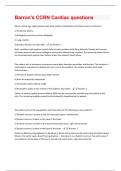Exam (elaborations)
Barron's CCRN Cardiac Questions and Answers well Explained Latest 2024/2025 Update 100% Correct.
- Course
- Institution
Which clinical sign might patients with both systolic and diastolic heart failure have in common? a) Peripheral edema b) Enlarged heart size on chest radiograph c) Lung crackles d) Ejection fraction less than 40% - Answer: C Both a problem with ejection (systolic failure) and a problem with fi...
[Show more]



